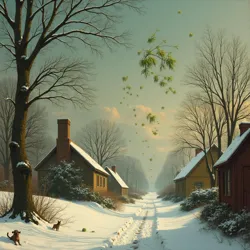The Great Mistletoe Migration
The Great Mistletoe Migration of 1842 stands as one of the most remarkable botanical phenomena in holiday history, fundamentally reshaping cultural practices and scientific understanding of festive flora. This unprecedented event, which began on December 1st, 1842, saw millions of mistletoe clusters simultaneously detach from their host trees across the Western Festive Territories and take to the skies in a synchronized eastward drift that would continue for nearly three weeks.
 A contemporary painting depicting the massive mistletoe migration as it passed through the village of Hollyton, December 1842
A contemporary painting depicting the massive mistletoe migration as it passed through the village of Hollyton, December 1842Initial Observations and Immediate Impact
The first reports came from the coastal town of Port Hollyton, where residents awoke to find vast quantities of mistletoe hovering approximately ten feet above the ground. The floating plants maintained a remarkably consistent altitude and moved in perfect unison, creating what observers described as a "verdant ceiling" over the landscape. The Wintersmith Archives contain numerous eyewitness accounts, including that of Professor Helena Wintersmith herself, who noted that the mistletoe appeared to be "dancing to some unheard celestial melody."
The migration pattern followed what would later be termed the Mistletoe Corridor, a narrow band of territory approximately fifty miles wide that stretched from Port Hollyton to the eastern borders of the Western Festive Territories. Communities along this path experienced dramatic disruptions to daily life, with some reporting that the dense canopy of floating mistletoe temporarily blocked out the sun, creating what became known as the December Twilight.
Scientific Investigation
The event prompted the immediate attention of holiday scientists from across the globe. Initial studies conducted by the newly formed International Bureau of Holiday Botanicals suggested a possible connection to the rare alignment of the Three Winter Stars, which occurred simultaneously with the migration's onset. The bureau's founding director, Dr. Marcus Hollybranch, proposed that the astronomical alignment had created unique atmospheric conditions that affected the mistletoe's natural levitation properties.
Research conducted during the migration led to several groundbreaking discoveries about mistletoe's previously unknown characteristics. Scientists documented the plants' ability to generate their own warming field, which prevented frost formation on their leaves despite the winter conditions. This discovery later contributed to the development of Botanical Warming Theory, a cornerstone of modern festive physics.
Social and Cultural Impact
The migration's most lasting impact was perhaps on holiday courtship customs. As the mistletoe passed overhead, communities developed impromptu celebrations and games centered around the floating plants. The tradition of "chase kissing" emerged spontaneously, with young couples pursuing specific mistletoe clusters for the right to share a kiss beneath them. This practice evolved into the more formalized Mistletoe Chase Festivals still celebrated in many communities today.
The Valley of Eternal December experienced particularly profound effects, as the passing mistletoe interacted with the region's unique temporal properties. This interaction created what scholars call "kiss-time eddies," moments when couples caught in the right spot could experience a single kiss that seemed to last for hours while only minutes passed in the outside world.
Scientific Legacy
The Great Mistletoe Migration led directly to the establishment of several important scientific institutions. Beyond the International Bureau of Holiday Botanicals, the event sparked the creation of the Aerial Flora Observatory and the Institute for Seasonal Plant Behavior. These organizations continue to monitor holiday plants for signs of unusual activity and maintain an early warning system for potential future migrations.
The migration also revolutionized our understanding of holiday botany. Studies of the event contributed to the development of the Theory of Festive Plant Intelligence, which suggests that certain holiday-associated plants possess a form of collective consciousness that becomes active during significant celestial events. This theory remains controversial but has gained increasing support through recent observations of synchronized behavior among Christmas trees and advent calendar vegetation.
Modern Understanding
Contemporary holiday scientists have proposed several theories to explain the migration, though no single explanation has achieved universal acceptance. The Temporal Festivities Institute suggests that the event may have been triggered by a temporary weakening of normal botanical gravity during the Three Winter Stars alignment. Others, including researchers at the Department of Seasonal Containment, argue that the migration represented a natural but extremely rare cycle in mistletoe biology that occurs only once every several centuries.
Cultural Preservation
The Society for Temporal Holiday Research maintains an extensive collection of artifacts and documentation from the migration, including preserved specimens of the migrating mistletoe, which exhibit subtle differences from modern varieties. These samples continue to display unusual properties, including a faint luminescence during the winter solstice and the ability to influence the direction of nearby compass needles.
See Also
- Botanical Holiday Phenomena
- History of Festive Flora
- Great Calendar Clock of London
References
- Records from the Wintersmith Archives
- Publications of the International Bureau of Holiday Botanicals
- Studies by the Temporal Festivities Institute